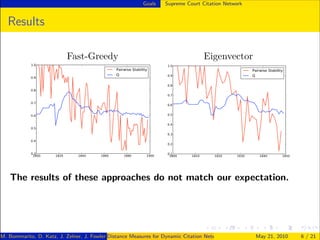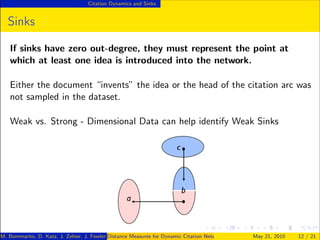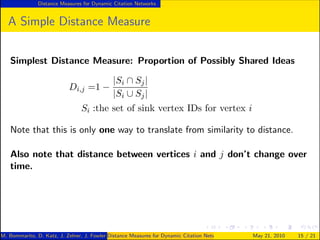Sinks Method Paper Presentation @ Duke Political Networks Conference 2010
- 1. Distance Measures for Dynamic Citation Networks M. Bommarito D. Katz J. Zelner J. Fowler May 21, 2010 M. Bommarito, D. Katz, J. Zelner, J. Fowler Distance Measures for Dynamic Citation Networks () May 21, 2010 1 / 21
- 2. Outline 1 Goals Supreme Court Citation Network 2 Citation Dynamics and Sinks 3 Distance Measures for Dynamic Citation Networks 4 How does the “sink” method perform? Simulation Results United States Supreme Court 5 Conclusion and Future Directions M. Bommarito, D. Katz, J. Zelner, J. Fowler Distance Measures for Dynamic Citation Networks () May 21, 2010 2 / 21
- 3. Goals Supreme Court Citation Network Goals & Data Goal: Can we uncover various mesoscopic patterns within the jurisprudence of the United States Supreme Court? 1 |V | ≈ 36k, |E| ≈ 280k 2 1791-2005 M. Bommarito, D. Katz, J. Zelner, J. Fowler Distance Measures for Dynamic Citation Networks () May 21, 2010 3 / 21
- 4. Goals Supreme Court Citation Network Standard Solution Standard Solution: Obtain vertex community membership by applying an out-of-the-box community detection method. Methods: 1 Edge-Betweenness (Girvan & Newman 2002) 2 Fast-Greedy (Clauset et al. 2004) 3 Leading (or more) Eigenvector (Newman 2006, Richardson et al. 2009) 4 Walktrap (Pons & Latapy 2006) M. Bommarito, D. Katz, J. Zelner, J. Fowler Distance Measures for Dynamic Citation Networks () May 21, 2010 4 / 21
- 5. Goals Supreme Court Citation Network Expectations Expectation: Dyadic relationships should be fairly stable. If two vertices are in the same community m at t, they should be in the same community n (not necessarily identical to m) at t + 1. Formally, this can be written as “pairwise stability” σ: σ =P(Cit+1 = Cj |Cit = Cj ) t+1 t Cit :community membership of vertex i at time t This conception of stability avoids many issues with community tracking. M. Bommarito, D. Katz, J. Zelner, J. Fowler Distance Measures for Dynamic Citation Networks () May 21, 2010 5 / 21
- 6. Goals Supreme Court Citation Network Results Fast-Greedy Eigenvector The results of these approaches do not match our expectation. M. Bommarito, D. Katz, J. Zelner, J. Fowler Distance Measures for Dynamic Citation Networks () May 21, 2010 6 / 21
- 7. Goals Supreme Court Citation Network Research Source Title: On the Stability of Community Detection Algorithms on Longitudinal Citation Data. Michael J. Bommarito II, Daniel M. Katz, Jonathan L. Zelner. Forthcoming in Proceedings of ASNA 2009 (ETH-Zurich). Goal: Compare out-of-the-box community detection methods under different parameters of a citation model w.r.t.: 1 Average number of resulting communities across all time steps 2 Average pairwise stability of all vertex pairs across all time steps M. Bommarito, D. Katz, J. Zelner, J. Fowler Distance Measures for Dynamic Citation Networks () May 21, 2010 7 / 21
- 8. Goals Supreme Court Citation Network Results M. Bommarito, D. Katz, J. Zelner, J. Fowler Distance Measures for Dynamic Citation Networks () May 21, 2010 8 / 21
- 9. Goals Supreme Court Citation Network Implications Citation networks are different. 1 Patterns within citation networks are not well-revealed by these methods. 2 Qualitative conclusions may vary dramatically based on the chosen method. 3 The “appropriateness” of each method may depend on parameters of the generating process. M. Bommarito, D. Katz, J. Zelner, J. Fowler Distance Measures for Dynamic Citation Networks () May 21, 2010 9 / 21
- 10. Citation Dynamics and Sinks Citation Dynamics What are the basic growth rules of a citation network? 1 Documents and their citations are introduced into the network in sequence. 2 Documents cannot create new outbound citations after introduction. These rules guarantee that any resulting network is an acyclic digraph. The simplest topological ordering is just the order of vertex introduction. M. Bommarito, D. Katz, J. Zelner, J. Fowler Distance Measures for Dynamic Citation Networks () May 21, 2010 10 / 21
- 11. Citation Dynamics and Sinks Dynamic Acyclic Digraphs What properties do we have? 1 Each component has at least one “sink” and one “source.” 2 Sinks are vertices with zero out-degree. The first vertex in a topological ordering must be a sink. 3 Sources are vertices with zero in-degree. The last vertex in a topological ordering must be a source. M. Bommarito, D. Katz, J. Zelner, J. Fowler Distance Measures for Dynamic Citation Networks () May 21, 2010 11 / 21
- 12. Citation Dynamics and Sinks Sinks If sinks have zero out-degree, they must represent the point at which at least one idea is introduced into the network. Either the document “invents” the idea or the head of the citation arc was not sampled in the dataset. Weak vs. Strong - Dimensional Data can help identify Weak Sinks M. Bommarito, D. Katz, J. Zelner, J. Fowler Distance Measures for Dynamic Citation Networks () May 21, 2010 12 / 21
- 13. Citation Dynamics and Sinks Six Degrees of Marbury v. Madison M. Bommarito, D. Katz, J. Zelner, J. Fowler Distance Measures for Dynamic Citation Networks () May 21, 2010 13 / 21
- 14. Distance Measures for Dynamic Citation Networks Basic Idea of the Distance Measure If two vertices share more “ideas,” they should be more similar. Alternative Example: Articles in Political Science 1 American Politics 2 Congress 3 Committee Assignments 4 Formal Theory We want to be able to use clustering methods, so we then construct a distance measure from this basic premise. M. Bommarito, D. Katz, J. Zelner, J. Fowler Distance Measures for Dynamic Citation Networks () May 21, 2010 14 / 21
- 15. Distance Measures for Dynamic Citation Networks A Simple Distance Measure Simplest Distance Measure: Proportion of Possibly Shared Ideas |Si ∩ Sj | Di,j =1 − |Si ∪ Sj | Si :the set of sink vertex IDs for vertex i Note that this is only one way to translate from similarity to distance. Also note that distance between vertices i and j don’t change over time. M. Bommarito, D. Katz, J. Zelner, J. Fowler Distance Measures for Dynamic Citation Networks () May 21, 2010 15 / 21
- 16. Distance Measures for Dynamic Citation Networks Flexible Framework for More Detailed Specifications What if the story is more complicated? 1 Minimum path length to a sink 2 Number of paths to a sink 3 Total number of shared ancestors 4 Total elapsed time along path Example with arbitrary f for path length and number of shared ancestors: s∈Si ∩Sj f (Ai,s , Pi,s , Aj,s , Pj,s ) Di,j =1 − s∈Si ∪Sj f (Ai,s , Pi,s , Aj,s , Pj,s ) M. Bommarito, D. Katz, J. Zelner, J. Fowler Distance Measures for Dynamic Citation Networks () May 21, 2010 16 / 21
- 17. How does the “sink” method perform? Simulation Results Simulation 1 Directed 2 Two vertex types 3 Asymmetric vertex connection probabilities 4 Preferential attachment mechanism (Two-Dimensional) M. Bommarito, D. Katz, J. Zelner, J. Fowler Distance Measures for Dynamic Citation Networks () May 21, 2010 17 / 21
- 18. How does the “sink” method perform? Simulation Results Simulation Results M. Bommarito, D. Katz, J. Zelner, J. Fowler Distance Measures for Dynamic Citation Networks () May 21, 2010 18 / 21
- 19. How does the “sink” method perform? United States Supreme Court United States Supreme Court Movie Available @ computationallegalstudies.com The Early Years of the United States Supreme Court M. Bommarito, D. Katz, J. Zelner, J. Fowler Distance Measures for Dynamic Citation Networks () May 21, 2010 19 / 21
- 20. How does the “sink” method perform? United States Supreme Court Supreme Court Results Using the Sink Method M. Bommarito, D. Katz, J. Zelner, J. Fowler Distance Measures for Dynamic Citation Networks () May 21, 2010 20 / 21
- 21. Conclusion and Future Directions Conclusion 1 There are issues with existing community detection methods in dynamic citation networks. 2 Our sink-based method provides more reasonable qualitative results than other methods we’ve tried. 3 Application to a larger segment of the SCOTUS data together with qualitative strategy designed to evaluate the outputs M. Bommarito, D. Katz, J. Zelner, J. Fowler Distance Measures for Dynamic Citation Networks () May 21, 2010 21 / 21





















